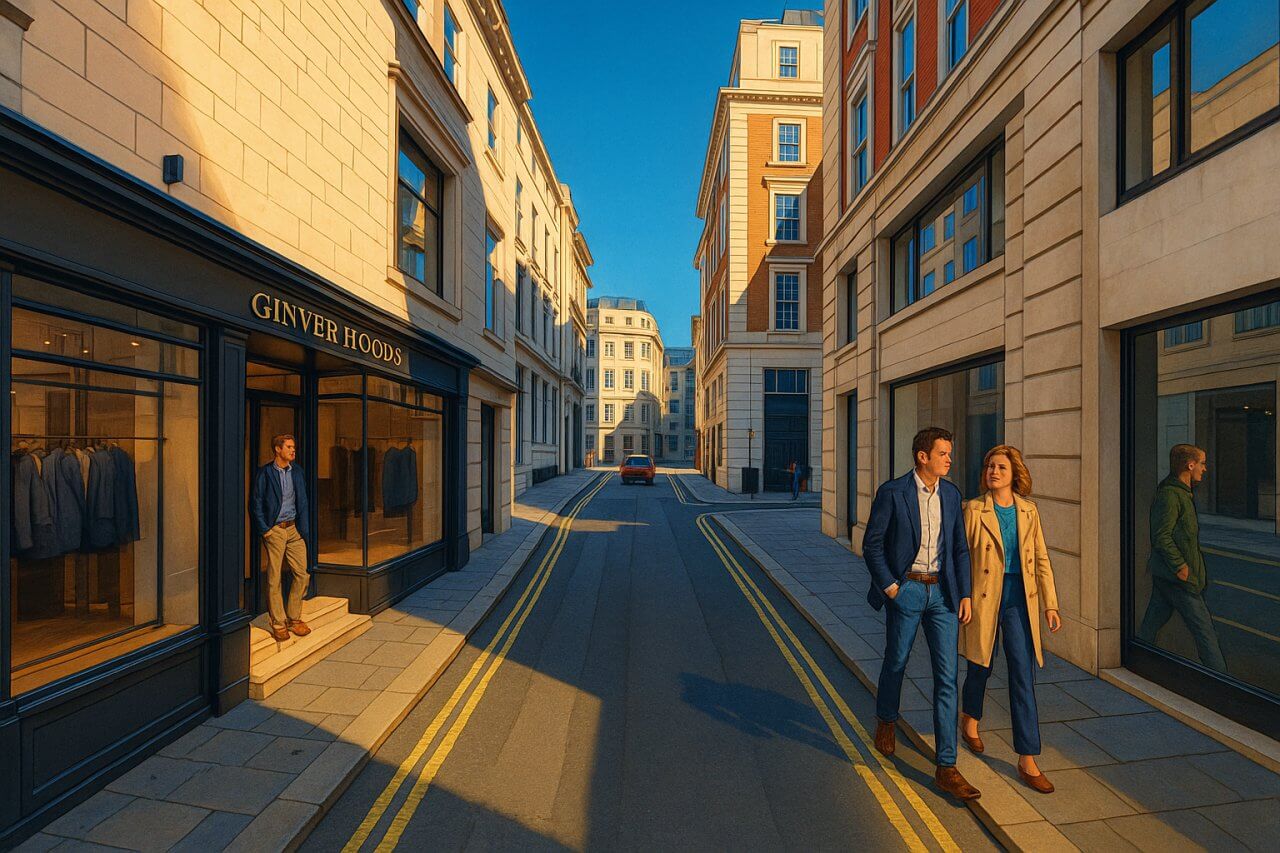
Vigo Street, London
Vigo Street is a short but historically rich street in the heart of London’s West End, and on the eastern fringe of Mayfair, located within the City of Westminster. (West End and Mayfair are not mutually exclusive and do overlap in this case) This one-way road connects the renowned tailoring destination of Savile Row and Burlington Gardens to the bustling Regent Street and Glasshouse Street. Despite its modest length, Vigo Street offers a wealth of cultural, historical, and architectural interest, especially for those exploring the area around Mayfair and Piccadilly.
Orientation and Layout
Vigo Street is a narrow, one-way street running east-west. Traffic enters the street from the junction of Savile Row and Burlington Gardens at its western end and exits at the eastern junction with Regent Street and Glasshouse Street. This one-way flow helps ease congestion near Regent Street while maintaining accessibility to the elegant shopping and office spaces nearby.
The road measures approximately 200 feet (61 metres) in length. While short in distance, it serves as an important pedestrian and vehicular connector within a dense commercial and cultural district.
History of Vigo Street
The origins of Vigo Street date back to the late 17th century, following the development of the surrounding Burlington Estate. It was originally part of Glasshouse Street before being renamed Vigo Lane to commemorate the Battle of Vigo Bay in 1702—a naval victory for the British and Dutch over the Spanish and French during the War of the Spanish Succession. It was later renamed once again to Vigo Street. A stretch of Vigo Street was renamed Burlington Gardens in 1831.
The name Vigo is pronounced VEE-go /ˈviːɡəʊ/  , and it reflects a tradition in Britain of naming streets after military victories. The renaming took place in the early 18th century, around the time the area became more developed and fashionable.
, and it reflects a tradition in Britain of naming streets after military victories. The renaming took place in the early 18th century, around the time the area became more developed and fashionable.
Character and Ambience
Vigo Street today retains a classic West End charm. It is lined with elegant period buildings, many of which are now used as boutique offices, fashion houses, or stylish flats. The character of the street blends Mayfair sophistication with Soho energy, given its location just west of Piccadilly Circus and near the borders of Mayfair and St James’s.
The ambience is typically quiet despite its proximity to the busy Regent Street, making it a discreet and prestigious address for high-end businesses and professionals.
Nearby Sights and Attractions
Although Vigo Street itself is compact, it is surrounded by some of London's most famous attractions:
- Savile Row: World-renowned for bespoke tailoring, home to storied establishments like Henry Poole & Co.
- Burlington Arcade: A luxurious covered shopping street running parallel to Vigo Street.
- Royal Academy of Arts: Located at Burlington House, a few steps from Vigo Street.
- Piccadilly Circus: Just to the east, offering shops, theatres, and historic London views.
Literature fans may be intrigued to know that the publishers John Lane and Elkin Mathews operated from Vigo Street in the 1890s. They were instrumental in publishing early works by Oscar Wilde and W.B. Yeats.
Property and Real Estate
Real estate on Vigo Street is highly sought after due to its central location. As of early 2025, commercial properties and office spaces along the street are valued between £2,500 and £3,500 per square foot (£26,900–£37,700 per sq metre), depending on the unit and floor level. Residential flats, which are rarer, tend to fetch between £1.8 million and £4 million for properties ranging from 850 to 1,800 square feet (79–167 sq metres), reflecting a premium over many parts of London.
These prices reflect the area's proximity to both the luxury of Mayfair and the commercial buzz of Regent Street, placing it among London’s most prestigious micro-locations.
Transport and Connectivity
Underground Stations
The closest London Underground station is Piccadilly Circus, approximately a 3-minute walk from Vigo Street. It is served by the:
Another nearby station is Oxford Circus (about 8 minutes on foot), served by the:
- Central Line
- Bakerloo Line
- Victoria Line
Bus Services
Numerous bus routes serve nearby Regent Street and Piccadilly, including routes:
- 12 (Oxford Circus – Dulwich Library)
- 88 (Camden Town – Clapham Common)
- 94 (Acton Green – Piccadilly Circus)
- C2 (Parliament Hill Fields – Victoria Station)
The nearest bus stops are on Regent Street St James’s and Piccadilly Circus.
Fun Fact
Vigo Street makes a quiet cameo in literature history: it was the publishing location for the first editions of Oscar Wilde’s The Picture of Dorian Gray and works by W.B. Yeats, marking it as a discreet but significant part of London’s literary past. The firm Lane & Mathews had their shop here in the 1890s and played a major role in the British literary renaissance of that era.
Quick Facts
- Location: City of Westminster, between Savile Row and Regent Street
- Traffic: One-way street from west to east
- Length: Approx. 200 feet (61 metres)
- Pronunciation: VEE-go /ˈviːɡəʊ/
- Named after: Battle of Vigo Bay, 1702
- Character: Elegant, quiet, central; offices and fashion-oriented
- Nearby Sights: Savile Row, Burlington Arcade, Royal Academy of Arts
- Property Prices (2025): £2,500–£3,500/sq ft (£26,900–£37,700/sq m) for commercial; up to £4 million for flats
- Nearest Tube: Piccadilly Circus (Piccadilly & Bakerloo Lines)
- Nearby Bus Routes: 12, 88, 94, C2
- Literary Fact: Oscar Wilde’s publishers were once based here
Map of Vigo Street, London

Painting of Vigo Street, London (View image in full size)